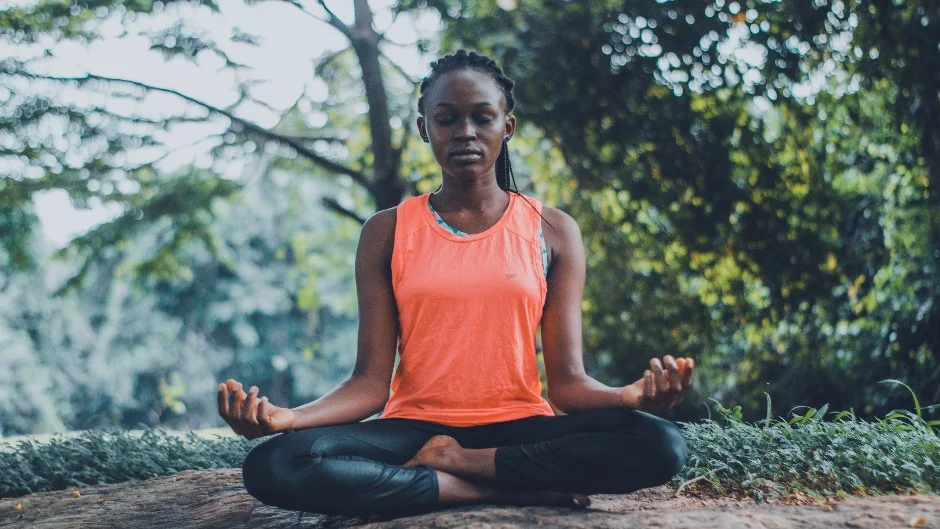4 Calming Breathing Exercises

Your breath connects your body and mind. Incorporating breath work into your daily practice can reduce stress and anxiety, improve sleep, and help you be more present during everyday activities. Every time you breathe in, both your heart rate and blood pressure rise. Conversely, every time you breathe out, both your heart rate and blood pressure drop. Our yoga instructors share some of their favorite breathing exercises.
2-to-1 breathing
Practice exhaling for twice the amount of time of the inhale.
- Sit or lie comfortably, becoming aware and sensitive to your breath.
- Begin to inhale for a count of four, then exhale for a count of six. After a few rounds, increase the exhale to a count of eight.
- If you are comfortable, you can also increase the inhale count, doubling it for the exhale. Relax, you do not need to stress yourself out by adhering to an uncomfortable count. As few as 10 breaths may produce a pleasant relaxation in your body and mind.
-Jason Orrell, yoga instructor
Ujjayi Pranayama (called Victorious Breath)
This breath practice is both energizing and relaxing because it sends fresh oxygen throughout the body. Start by practicing for five minutes and gradually build to 15 minutes for deeper meditation.
- Sit in a comfortable position. Relax your body and gently close your eyes. Place your arms to the sides or rest your hands in your lap.
- Inhale deeply though the nose and exhale with your lips pursed. Feel the air of the inhalations flow downward.
- On the exhalation, slightly contract the back of the throat like you do when you whisper. Softly whisper the sound, “ahhh,” as you exhale, and imagine you are fogging up a window.
- When you can comfortably control your thoughts during the inhalations and exhalations, keep the same constriction in your throat. You will continue to hear the ocean sound as you breathe through the nose.
- Concentrate on the breath and allow it to soothe the mind. Your breath should be audible to you but not so loud that someone standing a few feet away can hear it. Release this breath work when your practice is complete.
-Madelyn Freundlich, yoga instructor
Dirga Pranayama (Three-part breath)
This calming, grounding breathing practice helps to focus your attention on the present moment and get in tune with the sensations of your body.
This three-part breath practice can be done in a comfortable, cross-legged position or while lying on your back. When you are lying down, you can more fully feel the breath moving through your body as it makes contact with the floor.
PART 1
- Close your eyes and relax your face and body. Begin by observing the natural inhalation and exhalation of your breath without changing anything.
- Begin to inhale and exhale deeply through the nose. On each inhale, fill the belly up with your breath. Expand the belly with air like a balloon.
- On each exhale, expel all the air out from the belly through your nose. Draw your navel back towards your spine to make sure that your belly is empty of air.
- Repeat this deep belly breathing for about five breaths.
PART 2
- On the next inhale, fill the belly up with air. Then when the belly is full, draw in a little more breath and let that air expand into the rib cage causing the ribs to widen apart.
- On the exhale, let the air go first from the rib cage, letting the ribs slide closer together, and then from the belly, drawing the navel back towards the spine. Repeat this deep breathing into the belly and rib cage for about five breaths.
PART 3
- On the next inhale, fill your belly and rib cage up with air. Then, sip in just a little more air and let it fill the upper chest, all the way up to the collarbone, causing the area around the heart expand and rise.
- On the exhale, let your breath go first from the upper chest, allowing the heart center to sink back down, then from the rib cage, letting the ribs slide closer together.
- Finally, let the air go from the belly, drawing the navel back towards the spine. Continue at your own pace, eventually coming to let the three parts of the breath happen smoothly without pausing. Continue for about 10 breaths.
-Madelyn Freundlich, yoga instructor
Nadi Shodhana (Alternate Nostril Breathing):
This breathing practice clears out blockages throughout the energy channels (nadis) in the body, calms the mind, and brings awareness into the present moment. It is a very relaxed, balancing breath that can help calm the nervous system and aid in a restful night’s sleep.
- The breathing practice can be done seated or lying down. To start, empty all of the air from your lungs.
- Using the thumb of your right hand, block your right nostril and inhale through your left nostril only. Be sure to inhale into your belly, not your chest.
- Once you are full of breath, seal your left nostril with the ring finger of the same hand, keeping your right nostril closed, and hold the breath for a moment.
- Release your thumb and exhale through your right nostril only. Exhale all the breath out of the right side and pause before inhaling again through the same side. Seal both nostrils once you have inhaled on the right side and exhaled through the left side.
- A complete cycle of breath includes an inhalation and exhalation through both nostrils. Perform up to 10 cycles and notice how your body responds.
-Madelyn Freundlich, yoga instructor
You may also like:
How to Make Your Workouts More Mindful


